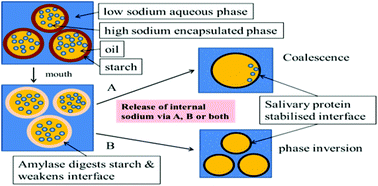Programmed emulsions for sodium reduction in emulsion based foods
Abstract
In this research a microstructure approach to reduce sodium levels in emulsion based foods is presented. If successful, this strategy will enable reduction of sodium without affecting consumer satisfaction with regard to salty taste. The microstructure approach comprised of entrapment of sodium in the internal aqueous phase of water-in-oil-in-water emulsions. These were designed to destabilise during oral processing when in contact with the salivary enzyme amylase in combination with the mechanical manipulation of the emulsion between the tongue and palate. Oral destabilisation was achieved through breakdown of the emulsion that was stabilised with a commercially modified octenyl succinic anhydride (OSA)-starch. Microstructure breakdown and salt release was evaluated utilising in vitro, in vivo and sensory methods. For control emulsions, stabilised with orally inert proteins, no loss of structure and no release of sodium from the internal aqueous phase was found. The OSA-starch microstructure breakdown took the initial form of oil droplet coalescence. It is hypothesised that during this coalescence process sodium from the internalised aqueous phase is partially released and is therefore available for perception. Indeed, programmed emulsions showed an enhancement in saltiness perception; a 23.7% reduction in sodium could be achieved without compromise in salty taste (p < 0.05; 120 consumers). This study shows a promising new approach for sodium reduction in liquid and semi-liquid emulsion based foods.


 Please wait while we load your content...
Please wait while we load your content...